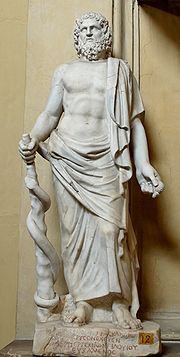The origins of the cult of Asklepios – as with many things in ancient Greece – goes back into the mists of time. The god Apollo, known as Maleas, was worshipped on Mount Kynortion above the site of the present theatre.
Those whom the gods destroy…
Legend has it that Asklepios was the son of Apollo and a Boeotian princess named Koronis. He was educated by the centaur Cheiron, who was very wise. Cheiron taught him surgery and the art of healing, especially the use of plants in medicine.
Because he was fathered by one of the gods and had supernatural gifts, together with the wise teaching he received, he became very knowledgeable. He was able not only to heal, but also to resuscitate the dead. Now in ancient Greece it was held that this was a skill reserved for the gods alone. One thing you didn’t do was to trespass into areas reserved for the gods. They became jealous, in particular Hades and Zeus. So Zeus sent a thunderbolt and struck him dead. His body was buried at Epidauros.

The growth of a cult
From about the 6th C BC a cult grew up around the figure of Asklepios. It was most powerful in the 4th C BC. The cult also included his daughters, Hygieia and Panaciea. If you wanted to make people think highly of you in ancient Greece as a doctor, you claimed that your knowledge came from him. Even the great Hippocrates of Kos claimed authority from him.
Many representations show him as a bearded figure supported by an augur’s staff. A magic serpent or snake often appears as well. These symbols later came to be included in the caduceus, the doctor’s emblem.
The Epidauros treatment
Epidauros became the center of healing for a large part of the Greek world. Visitors wanting to be healed would first make a sacrifice to the gods and undergo ritual purification. Then they would spend the night in the abaton (sacred dormitory). They slept on the skins of animals which had been used in sacrifice.
The ‘patients’ were encouraged to expect the god to appear to them in dreams. The priests would then be able to interpret the dreams and suggest suitable treatments. They also suggested the patients undergo physical exercise, relaxation, bathing and intellectual pursuits. It has been suggested that this is why the theatre and sports facilities became part of the complex.
If you were cured of your illness, you’d express your gratitude by a sacrifice and votive offering. The votive offering would be a representation of the part of your body which had been healed.
Every four years competitions were held in honour of Asklepios. It wasn’t just sporting activities which were held, the events included poetic and musical contests as well. The Greeks had a holistic view of themselves and their place in the world. They didn’t separate aspects of their lives into compartments as many of us tend to do. So their activities at these events included most areas of life – physical, mental and intellectual.
Visit another Asklepios healing center in Turkey